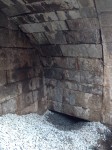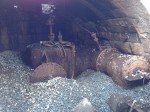 Archaeologists in Dartmouth, Nova Scotia, have unearthed a section of the town’s old canal system under the corner of Prince Albert Road and Pleasant Street. Lock 3 is a microcosm of the canal’s construction history, with parts dating to the 1820s and the late 1850s, early 1860s.
Archaeologists in Dartmouth, Nova Scotia, have unearthed a section of the town’s old canal system under the corner of Prince Albert Road and Pleasant Street. Lock 3 is a microcosm of the canal’s construction history, with parts dating to the 1820s and the late 1850s, early 1860s.
 The Dartmouth locks were part of the Shubenacadie Canal, one of Canada’s first canal systems which connected Halifax Harbour to the Bay of Fundy. The 70 mile-long system linked a network of rivers and lakes that had been used to transport people and cargo since the Mi’kmaq traveled the waterways by canoe at least 4,000 years ago. Nova Scotia’s governor Sir John Wentworth (in office 1792–1808) first conceived of deepening the Shubenacadie River and adding locks connecting it, Shubenacadie Grand Lake and other waterways. This would give ships a direct route through Nova Scotia, sparing them from the dangerous trip around Cape Sable and cutting travel time for the voyage from a week to a matter of hours.
The Dartmouth locks were part of the Shubenacadie Canal, one of Canada’s first canal systems which connected Halifax Harbour to the Bay of Fundy. The 70 mile-long system linked a network of rivers and lakes that had been used to transport people and cargo since the Mi’kmaq traveled the waterways by canoe at least 4,000 years ago. Nova Scotia’s governor Sir John Wentworth (in office 1792–1808) first conceived of deepening the Shubenacadie River and adding locks connecting it, Shubenacadie Grand Lake and other waterways. This would give ships a direct route through Nova Scotia, sparing them from the dangerous trip around Cape Sable and cutting travel time for the voyage from a week to a matter of hours.
Construction didn’t begin until 1826, six years after Wentworth’s death. The Shubenaccadie Canal Company, formed by a group of wealthy merchants including shipping magnate Samuel Cunard, engaged civil engineer Francis Hall to design the system. Hall was from Scotland where he had worked as a surveyor on the Edinburgh & Glasgow Union Canal. He and his family emigrated to Canada in 1823 where he soon found work surveying and designing canals and bridges. Construction began with the arrival of 44 stone masons from Scotland and Irish labourers who had extensive experience constructing granite locks in the British style. The company even imported granite from Aberdeen to build the locks.
 Hall’s plan was for a system of almost 20 locks. As each one being hugely expensive in imported materials and specialized labour, work ground to a halt in 1831 when the Shubenaccadie Canal Company ran out of money with only 13 locks either finished or begun. More than 20 years passed before the project was revived. In 1853 a new company was formed, the Inland Navigation Company, and it approached the construction of the canal with far more modest (and cheap) goals. Engineer Charles W. Fairbanks tailored the canal to two specific kinds of ships made by the Inland Navigation Company, both smaller than the merchant ships Hall had designed for, which allowed him to forgo the expensive imported granite locks in favor of American-style locks made of local stone and wood, replace several of Hall’s planned locks with inclined planes and reduce the draft depth from eight feet to four and a half.
Hall’s plan was for a system of almost 20 locks. As each one being hugely expensive in imported materials and specialized labour, work ground to a halt in 1831 when the Shubenaccadie Canal Company ran out of money with only 13 locks either finished or begun. More than 20 years passed before the project was revived. In 1853 a new company was formed, the Inland Navigation Company, and it approached the construction of the canal with far more modest (and cheap) goals. Engineer Charles W. Fairbanks tailored the canal to two specific kinds of ships made by the Inland Navigation Company, both smaller than the merchant ships Hall had designed for, which allowed him to forgo the expensive imported granite locks in favor of American-style locks made of local stone and wood, replace several of Hall’s planned locks with inclined planes and reduce the draft depth from eight feet to four and a half.
Sections of the new canal system were in use by 1856 and the whole thing was completed in 1861. It transported carried sheep, cotton, linen, rope, fish, coal, gold and people, enough goods and passengers to make a modest profit. In 1862, Hall’s Scottish marble locks in Dartmouth were closed in to create a chamber in which a turbine was installed to power a marine railway that carried boats through the canal via pulley, but the clock was already ticking by that point. The Nova Scotia Railway had begun construction in 1853 — shipping iron for the railroad was actually one of the canal’s most significant revenue streams — and it soon became the preferred conveyance for freight shipments. By 1870, the railroad had replaced the draw bridges built over the canal with fixed rail bridges which blocked canal access to ships of even modest height. Commercial operations on the canal came to an end.
 Meanwhile, in 1864 Dartmouth’s Lock 3 was taken over by Starr Manufacturing. Founded by hardware merchant John Starr, Starr Manufacturing built a factory on the site and used the original marine railway turbine to power its plant. The plant first produced cut nails and other iron goods, but it soon turned to the production of spring steel skates invented by Starr employee John Forbes. By 1868, Forbes was general manager of the company and the Forbes Spring Skate was internationally renown. The growth of the railway that had killed the canals came full circle in the 1870s when Starr Manufacturing began to produce coal cars, railway spikes and even made a heavy iron railway bridge, designed by John Forbes and built in Elmsdale.
Meanwhile, in 1864 Dartmouth’s Lock 3 was taken over by Starr Manufacturing. Founded by hardware merchant John Starr, Starr Manufacturing built a factory on the site and used the original marine railway turbine to power its plant. The plant first produced cut nails and other iron goods, but it soon turned to the production of spring steel skates invented by Starr employee John Forbes. By 1868, Forbes was general manager of the company and the Forbes Spring Skate was internationally renown. The growth of the railway that had killed the canals came full circle in the 1870s when Starr Manufacturing began to produce coal cars, railway spikes and even made a heavy iron railway bridge, designed by John Forbes and built in Elmsdale.
 The plant building was destroyed by fire in 2000, but the canal lock underneath survived. It was filled with gravel to help protect it. Now the site is being excavated as part of the Dartmouth Canal Greenway project, which will integrate the historic canal engineering into an open green space through downtown Dartmouth. The turbine chamber was found to be in good condition, with the east and west walls from Lock 3 of the first canal dating to 1828-1830 still standing. The north and south walls that meet in an arch are from the 1860s construction when the canal was closed in, the turbine chamber created and the turbine installed to power the rail.
The plant building was destroyed by fire in 2000, but the canal lock underneath survived. It was filled with gravel to help protect it. Now the site is being excavated as part of the Dartmouth Canal Greenway project, which will integrate the historic canal engineering into an open green space through downtown Dartmouth. The turbine chamber was found to be in good condition, with the east and west walls from Lock 3 of the first canal dating to 1828-1830 still standing. The north and south walls that meet in an arch are from the 1860s construction when the canal was closed in, the turbine chamber created and the turbine installed to power the rail.
Contractors and engineers craned their heads to take in the arches in the turbine pit during Wednesday’s visit as Stewart pointed out the original Irish mason’s markings of asterisks and the letter H carved into the grey rock.
During the excavation, Stewart said they’ve found architectural pieces of interest as well as multiple skate blades, which would have come from the Starr Plant. […]
Part of the reconstruction will include historical interpretation where a clear covering could protect the historic site, while allowing people to peer into the chamber and see a computer-generated example of the original canal turbine.
For more about the history of the Shubenacadie Canal, watch this half hour documentary:
[youtube=https://youtu.be/XB2A2myByTI&w=430]